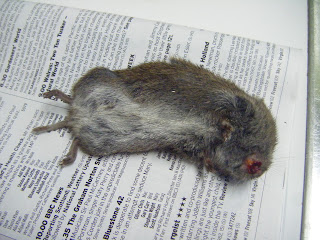I have become more interested in bones since I broke my ankle and got to look at the X-ray:
My ankle is now held together with various bits of metalwork. I had mistakenly thought that my ankle was made up of several separate bones but it looks as though most of it is the ends of your leg bones and the big bone that forms your heel.
Over the past year, I have found several owl pellets. Some were on the balcony area of our shed, and some were found on boulders up Glen Banchor. Both places are where owls can perch and digest their catch. Owl pellets are made up of the non-digestible parts of their food and are regurgitated as pellets of fur and bones.
Dissecting an owl pellet is probably the closest most of us will get to being a forensic pathologist and doing a postmortem!
 |
| Owl pellets - some intact (top right) and some starting to disintegrate (on left) |
 |
Some I could identify such as the pelvic bone bottom left.
|
 |
| Pelvic bone with the pin pointing to the round socket (for the ball of the leg bone (femur) to fit in) |
The skulls are made of very thin bones which fragmented but I did find one almost complete skull.
 |
| Skull |
The jaw bones tended to survive best, and the teeth patterns provide a way of identifying what creature was eaten.
 |
| Upper jaw |
 |
| Tooth pattern |
I think most of the remains were from Field Voles. My dog regularly catches Field Voles when out on a walk and unfortunately some also make their way into the house and get caught in the mouse trap.
Occasionally I see evidence of Voles in the garden - a hole and leaves under a flower tub or once I saw two fighting and squeaking (at least I thought they were fighting - maybe it was something more romantic?)









